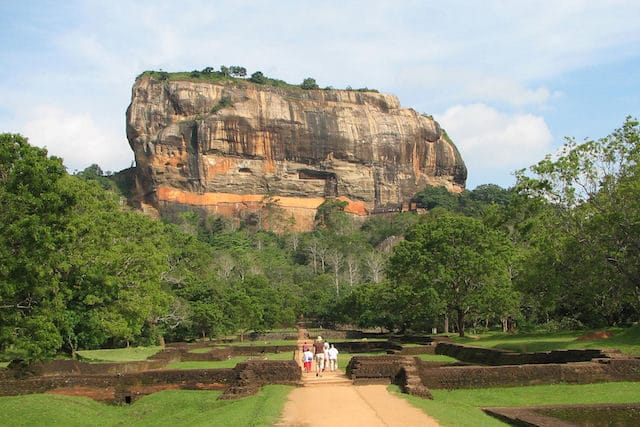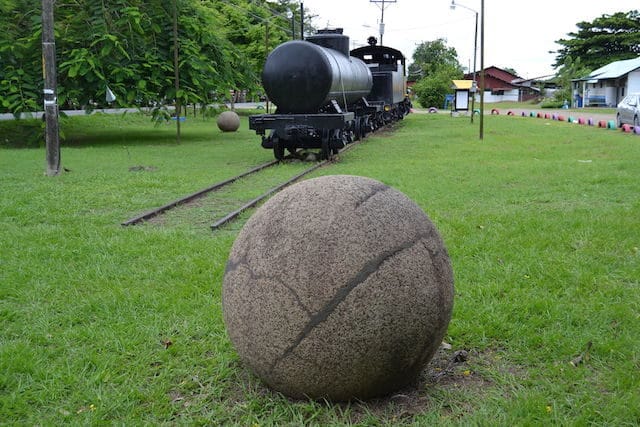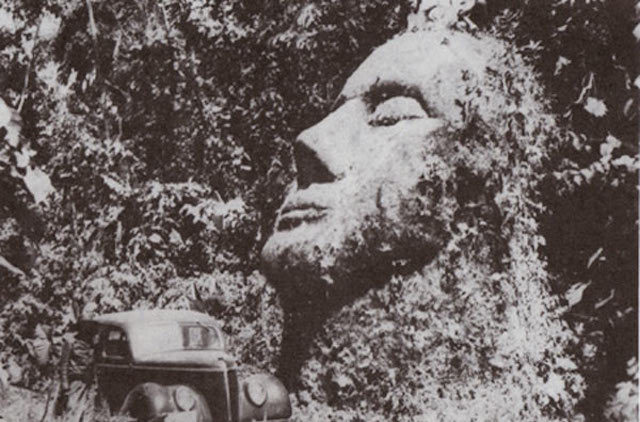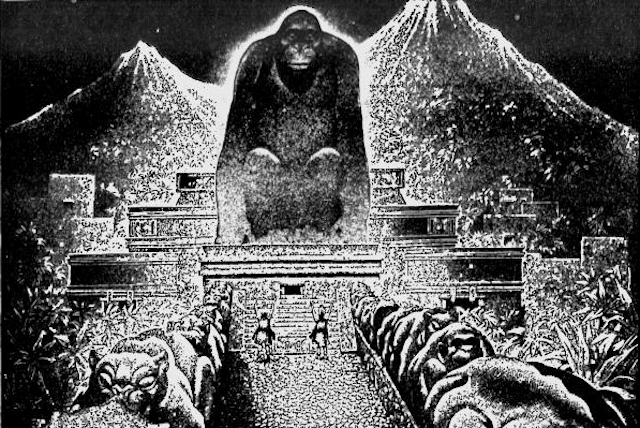The jungles are, and always have been mysterious. People can and have gone in them, never to be seen again. And even if they make up just 7 percent of the Earth’s land surface, with that number going down year after year, they are home to half of all living creatures on the planet. And what’s more, we don’t even know many of them. Nevertheless, the jungle can hide a great deal of mysterious things. Here are 10 of them.
10. A Long Lost Mayan City Found by Looking at the Stars
It’s a fairly well-known fact that the Maya were good astronomers. The Mayan calendar may ring some bells, though it is often confused with the Aztec Calendar. And it never does get as much credit as it should. Nevertheless, a 15-year-old boy by the name of William Gadoury, from Quebec, Canada, has put the Mayan stargazing ability to the test. He theorized that the ancient pre-Colombian civilization used to build their cities in accordance with the overhead constellations. By making use of images from the Canadian Space Agency, Google Earth, as well as other known Maya settlements, he was able to pinpoint and discover marks which indicate a possible hidden city deep in the Yucatan jungles of Mexico.
Though nobody actually went there to analyze the site first hand, mostly because of the dense vegetation, the images provided by the satellite point to a possible pyramid complex hidden beneath the overgrown canopy. The satellite discovered linear elements that resemble a street network, as well as a rectangular shape that may actually be a pyramid. These images could, of course, show nothing more than natural features interpreted as man-made, but this is highly unlikely. Straight lines and rectangular shapes are rarely found in nature on their own, and are almost always a sign of human activity. If proven to be true and there actually is an undiscovered Maya settlement there, then this technique could prove useful in finding other lost cities just by looking at the stars.
9. The Largest Flower in the World

Growing some 3.3 feet across and weighing in at around 24 pounds, the Rafflesia Arnoldii is the largest flower in the world. There are 17 known species and they all live deep in the rainforests of Indonesia, Malaysia, Borneo, Sumatra, Thailand, and the Philippines. But this isn’t your ordinary flower to give your girlfriend on Valentine’s Day. Not because she doesn’t have a big enough vase to put it in or anything, but because this flower is notorious for its smell of rotten flesh when in full bloom. Also known as the “corpse flower”, it makes use of this particular “perfume” in order to draw in its main pollinator: the carrion fly. It sports five immense, red colored, leathery petals and a deep well in the middle. The flies go inside hoping to find some rotting flesh, but instead are covered with the flower’s pollen.
The corpse flower is also a parasite. It doesn’t have any leaves, stem, or roots and instead makes use of some threadlike growths that go inside its host: the Tetrastigma Vine. Prior to its bulb sprouting, there are no visible signs of the flower’s existence. It can take up to ten months for the flower to go from bulb to full bloom. And when it does, it stays like that for only a few days; a week at best. Nobody really knows when that happens and it is extremely hard to make one do so in captivity. Singapore’s Botanic Garden hasn’t yet been successful in growing its own. So, if you really want to see one live, your best bet is to go deep within the Southeast Asian jungles to find one.
8. The Boiling River of Amazonian Legend
When he was only a boy, Andrés Ruzo, a geophysicist, was told a legend by his grandfather. This legend was about the conquistadors and how they went in search of El Dorado, the city of gold, deep in the Amazonian jungles. And from the fortunate few that were able to return came all sorts of stories. These stories were about man-eating snakes, jungle people with poison darts, trees bigger than they’d ever seen, and a boiling river capable of instantly killing anyone who would fall in its waters. This story remained with Ruzo into his adulthood. And for his PhD, he decided to make Peru’s first detailed geothermal map. Now, boiling streams do exist. They are located near volcanoes or other geothermal hotspots. But the thing is that the Amazonian basin is nowhere near such places, and the existence of a boiling river would be next to impossible. But as fate would have it, his aunt, of all people, was familiar with the boiling river. Not only had she been there before, but she was friends with the river shaman’s wife.
She then took him there, some 440 miles away from any volcanoes, and deep within the Peruvian jungle. The river itself is about 82 feet wide and 20 feet deep in some places, and for a distance of about 4 miles its waters are close to boiling point. This site is known as Mayantuyacu, and is considered sacred by the natives. What’s even more interesting is the fact that they use its waters for everything from cooking, brewing tea, or washing. But since this place is nowhere near a volcano, there isn’t a simple answer as to where the heat comes from. The best explanation so far, which probably is the case, is that this water comes from far away, as far as the glaciers high up in the Andes Mountains. Then it goes through an immense network of fissures within the mountains themselves, then deep underground where it’s heated, only to come back out in this place, making this stretch of the river boil.
7. Sigiriya – The Eighth Wonder of the World

Located on the teardrop-shaped island of Sri Lanka, there is an abandoned fortress/palace that some say is the Eighth Wonder of the World. Sigiriya’s origin dates back to the 5th century AD during the reign of King Kashyapa, 477-495, and was built on a 600 foot tall, vertical granite slab towering over the surrounding jungle. King Kashyapa came to power after successfully overthrowing his father and usurping his brother’s rule on the throne of Sri Lanka. He later killed his father by walling him up while still alive. Fearing for his life, his brother, Moggallana, fled to Southern India, where he would raise an army, determined to take back the throne from King Kashyapa. Knowing this, Kashyapa then moved the capital from Anuradhapura, to the strategically located Sigiriya. The site was chosen due to its defensive capabilities. The granite slab itself was a “plug” that once covered the mouth of a volcano. But over time, the volcano subsided and eroded, leaving only the huge stone in place.
Now only a ruin, Sigiriya was once a crowning technological achievement and quite possibly the most important urban planning site of the first millennium in the world. The complex was comprised of the royal palace located at the very top, a mid-level terrace that includes an exquisite gate shaped in the form of a huge lion, and the lower part, which was made up of other smaller palaces, elaborate gardens, and the city itself. The western wall of the granite stone was a covered in huge murals, 460 feet long and 130 feet high; probably the biggest in the world. The frescoes depicted over 500 partially undressed ladies, maybe the king’s mistresses, or probably priestesses during various religious ceremonies. The spiral stairs that went up to the palace were built next to the Mirror Wall. This was once covered in plaster and polished to the point where the king could see his reflection when going up to the palace.
Things, however, didn’t last. The king’s brother did eventually return with an army and defeated Kashyapa in battle. Taking back the throne of Sri Lanka, he moved the capital back to Anuradhapura and transformed Sigiriya into a Buddhist monastery that lasted up until the 14th century. The site was then abandoned for 500 years, only to be rediscovered by accident when some British troops went past it in 1831. The first small scale archeological work began in the 1890s, and only in 1983 did the Sri Lankan government get involved. Since then Sigiriya has become a UNESCO World Heritage Site.
6. Cuvette Centrale – Congo’s Hidden Carbon “Bomb”
For the past three years, scientists have been meticulously mapping the Congo Basin and what its soil has buried just below the surface. As it turns out, there is one of the largest carbon sinks in the world, covering an area larger than England, some 56,000 square miles in total. This swampland, even though it makes up just 4 percent of the whole Congo Basin, holds as much carbon below ground as the amount stored above ground (in the form of trees and vegetation) for the rest of the basin put together. That’s roughly 30 billion tons of carbon, or about 20 years’ worth of fossil fuel emissions in the US. When the investigations started, scientists had no idea of what they’d come across, and this peatland turned out to be 16 times larger than previously anticipated. Peat is decomposing organic matter turned partially into soil. It is most commonly found in cooler regions like Siberia, Northern Europe, or Canada, but they’re also found in tropic regions like this one.
When plant matter dies it falls into these marshlands and gets partially decomposed. But because of the water above, this decomposition stops midway. Left alone, peatlands make great carbon sinks, sucking up carbon from the air via plants and then storing it underground when these plants die. This particular marshland started forming roughly 11,000 years ago with the end of the last ice age, when Africa became more humid in its tropical regions as a result. However, if for whatever reason the water is drained or it evaporates, then the peat starts decomposing again, releasing all the carbon into the air with devastating effects. Now, because it was only recently discovered and is basically unprotected, this peatland is vulnerable to deforestation and drainage in order to make room for agriculture, particularly for palm oil. The same thing happened in Indonesia, where over 36,000 square miles of peatland were exposed in recent decades, in order to make room for palm tree plantations.
5. The Stone Spheres of Costa Rica

Ever since the late 1930s, people have been discovering strange stone spheres scattered all across southern Costa Rica. In order to make room for banana plantations, farmers began clearing the jungle only to come across these round balls ranging in size from only a few inches to over 6.6 feet in diameter, and weighing in as much as 15 tons. Not knowing what to make of them, the farmers either pushed them aside with bulldozers or blew them up with dynamite. Word got around that there was gold inside, so people began destroying them, but, surprise surprise, there was no gold.
Nevertheless, they did get proper archeological investigation soon after their discovery. Some of the stone spheres, which were left in their original place, were found alongside pottery shards dating from around 300 to 1550 AD. But most of them are believed to have been made around the year 1000 AD, more than 500 years before the Spanish Conquest. There isn’t much information about their creators, however, with the culture disappearing soon after the European arrivals. Nevertheless, archaeological evidence points to the fact that these people lived in scattered settlements no larger than 2,000 people at a time. They also made use of agriculture and lived in circular houses. Go figure!
To create these spherical stones, this ancient civilization probably used a combination of techniques such as controlled fracture, pecking, and sand grinding. Contrary to what you might hear about them from various sources, they are nowhere near to being perfect spheres. But given the technology at the time, they are impressive nonetheless. Their purpose, on the other hand, is a complete mystery. Since they were removed from their original positions, we can only imagine their intended purpose. While some of the stones were still on site during the 1940s and ’50s, archaeologists documented them as being arranged in straight or curved lines. One such arrangement was said to be in direct alignment with the magnetic north. Others were said to be on top of low mounds, leading scientists to speculate that some of them, at least, were kept indoors. But because many of these stones have been relocated, it makes it impossible to verify. Today, most of the stone spheres adorn public places and even private gardens. Many of them have since found their way to other countries as well, particularly in the US.
4. Zombie Fungus
The Cordyceps are a genus of fungi with a worldwide distribution. But most of the almost 400 species are found in the humid and tropical regions of Asia, in countries like China, Nepal, Japan, Bhutan, Korea, Vietnam and Thailand. What they do, is that they infect an insect, usually an ant (but it depends of the species of Cordycep), and then they take control over the poor animal. Since 85% of all insects in the world live in rainforests, the fungus’ preference for ants kinda makes sense. For instance, it’s estimated that over 8 million ants cover a single hectare of tropical forest.
When these ants come in contact with the spores of these fungi, they immediately get infected. And as if out of a sci-fi movie, the fungi then takes control over the actions of the ant, making it climb the foliage as high as it can. There, the ant will fix itself to a leaf or a twig, and it will eventually die. Next, the fungus will sprout from the ant’s head, forming a long stem over the following three weeks. Then, the next generation of spores will burst from its tip and will fall to the ground, ready to be picked up by other ants, and the cycle repeats itself.
The higher the ant goes, the wider the distribution these spores have, and the more ants can pick them up. Now, if other ants come by an infected one, they immediately take it as far away from the colony as possible and dump it there, in order to prevent infection. What’s really interesting about these “zombie fungi” is that each species specializes on just one type of insect; not just ants. This indicates that there’s a close coevolution between the parasite and the host. And what these fungi ends up doing on a grander scale is that they keep any one species from getting the upper hand. If one group of insects becomes too numerous, they have a higher chance of getting infected, thus constantly promoting diversity in the jungle.
3. The Lost Stone Head of Guatemala

Back in 1987, a doctor of philosophy by the name of Oscar Rafael Padilla Lara received a photograph of a giant stone head located somewhere in the jungles of Guatemala. The photograph was reportedly taken during the 1950s by a man who owned the land where the head was located. Dr. Padilla then tracked down the landowner and went looking for the head. Unfortunately, however, when they got there the head was gone. Well, it was still there, actually; it just no longer looks like a human head. From 1960 to 1996, Guatemala was ravaged by civil war and it seems that the mysterious stone head was used as target practice by the rebels. The site is located some 6 miles away from the small village of La Democracia in southern Guatemala. Dr. Padilla measured what remained of the monolith to a height of about 20 feet. But since the war was still taking place at the time, he never returned to the site.
Now, there have been other stone heads discovered in the country, as well as southern Mexico, which were created by the Olmec civilization during the first and second millennium BC. What makes this stone head so special, however, is the fact that it doesn’t look anything like the others. While the Olmec monuments resemble a more “Negroid” appearance – something that sparked all sorts of wild theories – this one had a more “Caucasian” look to it, which again ignited alien conspiracies. Some, nevertheless, speculate that this head was maybe an anomaly in the Olmec period, or maybe it was made by another culture altogether, before or after the Olmecs themselves. Others believe that, similar to the Easter Island Statues, there may be a body underneath yet to be discovered. But there is some controversy about the whole story. Due to the odd nature of the discovery and the unlikely and seemingly unfortunate series of events surrounding it, some believe the head to be a hoax. The answer, however, is still hidden within the Guatemalan jungles.
2. Real Life Tarzan
https://www.youtube.com/watch?v=qqiqgv4p-QM
It’s a known and accepted fact that those who venture into the jungle have a big chance of never coming back out again. There are plenty of things that can go wrong and they sometimes do. But it’s not that common for people to lose themselves in the jungle willingly. But on extremely rare occasions, this happens as well. This was the case of a man and his then-infant son, who’ve been living in the Vietnamese jungles for over 40 years. During the Vietnam War, Ho Van Thanh, now over 80 years old, took his youngest son, Ho Van Lang, deep within the jungle in order to escape an US air raid that killed his wife and two older sons. Unbeknownst to him, however, his wife gave birth to another son just before the air raid, and this baby also managed to somehow survive, and was then taken by his uncle, Thanh’s brother.
Forty years later, the two were discovered some 25 miles away from the nearest village, living in a tree house constructed close to a stream. The two also crafted their own makeshift tools like axes, knives and even arrows, and were even tending a sugarcane plantation. They also had a small fire going in the suspended hut and made their own underpants from dried tree bark. When discovered, the father was barely able to walk due to his old age, and even forgot most of the language. His son, though thin, was in peak physical condition, but like his father, didn’t know the language. Neither of them was suffering from any diseases. When taken back to the village, the father was taken to the hospital in order to receive proper medical treatment. However, doctors had to tie him to the bed because he kept trying to escape back into the jungle.
1. The White City of the Monkey God

Ever since the time of Hernan Cortez and his conquest of the Aztecs, there have been legends of a mighty city somewhere deep in the unexplored jungles to the south. This city was said to be so wealthy and so powerful that nobles were eating their food from plates of gold. And in charge of this city was an all-powerful monkey god. The Bishop of Honduras sent a letter to the King of Spain in 1544, telling him that after an arduous travel through the dense jungles, guided there by some locals, he saw the city from the top of the mountain in one of the valleys below. After that, the legend only continued to grow. That was until 1939, when an explorer by the name of Theodore Morde claimed to have found it in the Mosquita Valley area in Honduras. However, he was later found dead in his parent’s house, having supposedly hanged himself, never revealing the actual location.
However, a recent archaeological expedition in the area has actually discovered the site by making use of state of the art technology. The ancient city is located in a crater-like valley, surrounded by mountains and covered by almost impenetrable vegetation. The exact location is, however, kept a secret in the hopes of keeping looters away. The archaeologists have since managed to map an extensive area of the site, discovering plazas, earth pyramids, and countless valuable artifacts and stone statues. Though they don’t believe in an actual “White City of the Monkey God,” they do believe that they’ve stumbled upon something even greater: a previously unknown civilization that inhabited the area long ago.